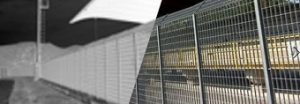
The latest generation of cost-effective thermal cameras from Hikvision, are designed to make it faster and easier for small and medium businesses to secure their perimeter – even in the dark, and in challenging weather conditions such as fog, heavy rain, and snow. As the perimeter is recognised as the first line of defence against intruders, many forward-looking businesses today are turning to a solution to ensure quick and effective detection and response even in low visibility conditions. That solution is to deploy thermal cameras, which offer a number of advanced benefits.
Effective even in low-visibility conditions
In complex light environments, at night, or in severe weather conditions, many conventional ‘visible light’ cameras may not be able to recognise intruders and alert security teams. By contrast, thermal cameras can recognise tiny changes in temperature, allowing them to detect people or vehicles that cross perimeter boundaries even in extremely low-light or low-visibility conditions.
Minimising false alarms
Some thermal cameras incorporate deep learning algorithms to distinguish humans and vehicles from animals, falling leaves, and other moving objects that could otherwise trigger false alarms. This means that intrusion alarms are only triggered when a real perimeter threat is identified, which supports a faster response with far less time spent analysing footage and investigating false alarms.
Increased efficiency
Another key benefit of thermal cameras is that they are effective at longer distances than many conventional ‘visible light’ cameras. This means that small and medium businesses can reduce equipment and installation costs for their perimeter-protection solutions, while also monitoring camera feeds with fewer team members.
Hikvision offers a range of affordable thermal cameras that are ideally suited for perimeter protection in small and medium applications such as residential areas, office buildings, car parks, factories, stores, and even museums.
With Hikvision’s leading thermal camera range, detection in real time of people or vehicles that breach perimeter defences is made possible, even in low-light and poor-visibility conditions. As an added benefit, overlay of traditional video images on top of thermal camera images is possible, which ensures availability of evidence needed to support legal processes or insurance claims in the event of a perimeter breach.











